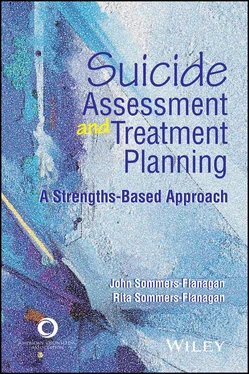John Sommers-Flanagan - Suicide Assessment and Treatment Planning
Здесь есть возможность читать онлайн «John Sommers-Flanagan - Suicide Assessment and Treatment Planning» — ознакомительный отрывок электронной книги совершенно бесплатно, а после прочтения отрывка купить полную версию. В некоторых случаях можно слушать аудио, скачать через торрент в формате fb2 и присутствует краткое содержание. Жанр: unrecognised, на английском языке. Описание произведения, (предисловие) а так же отзывы посетителей доступны на портале библиотеки ЛибКат.
- Название:Suicide Assessment and Treatment Planning
- Автор:
- Жанр:
- Год:неизвестен
- ISBN:нет данных
- Рейтинг книги:4 / 5. Голосов: 1
-
Избранное:Добавить в избранное
- Отзывы:
-
Ваша оценка:
- 80
- 1
- 2
- 3
- 4
- 5
Suicide Assessment and Treatment Planning: краткое содержание, описание и аннотация
Предлагаем к чтению аннотацию, описание, краткое содержание или предисловие (зависит от того, что написал сам автор книги «Suicide Assessment and Treatment Planning»). Если вы не нашли необходимую информацию о книге — напишите в комментариях, мы постараемся отыскать её.
Suicide Assessment and Treatment Planning — читать онлайн ознакомительный отрывок
Ниже представлен текст книги, разбитый по страницам. Система сохранения места последней прочитанной страницы, позволяет с удобством читать онлайн бесплатно книгу «Suicide Assessment and Treatment Planning», без необходимости каждый раз заново искать на чём Вы остановились. Поставьте закладку, и сможете в любой момент перейти на страницу, на которой закончили чтение.
Интервал:
Закладка:
If you are an avid reader, you can get swept into information about death and suicide and forget to take a break. Planning intermittent breaks from this book and other suicide-related material is wise. You can use the Pomodoro technique: Set a timer for 20 or 30 minutes, and then take a break. Consider inserting a fun, creative, social, or reflective activity into your break time.
You can use a variation on this “stop reading” approach during counseling sessions. For example, if you are feeling overwhelmed in a session, it is perfectly reasonable to take a break from information gathering and instead focus on coping in the moment. You might say something like “When we’re talking about intense topics in counseling, we should also practice positive coping strategies at the same time. So let’s pause, take some breaths, and then talk about how we can weave coping strategies like deep breathing and problem-solving into our session.”
Taking breaks is one coping technique, but not the only one. We recommend having a variety of strategies for self-care. Based on numerous research studies, Norcross and Vandenbos (2018) identified effective strategies that professionals use to manage stress. What follows is our version of Norcross and Vandenbos’s recommendations.
Recognize the Hazards
Facing and talking about death is an emotional undertaking. Do not expect to read this book without experiencing some distress. Humans are not built to continually focus on suicide and death. If you would rather avoid topics of suicide and death, join the club. You are not being weak. Recognizing and accepting that too much focus on suicide and human mortality can be hazardous to well-being is a healthy and reasonable start.
Once you have admitted that this is not easy, then you can take steps to address the dangers and make accommodations for yourself as necessary. The sections below offer suggestions, but you know yourself and what you need, so you may want to make your own list.
Intentionally Focus on Positive and Rewarding Life Experiences
Professionals who cope effectively with powerful life stressors do not wait for positive experiences to come to them—they weave health-enhancing activities into their daily lives. As a counselor, you will hear harrowing client stories and be susceptible to vicarious traumatization (Foreman, 2018; Trippany et al., 2004). To care for yourself and to be a positive role model for clients, it is essential that you integrate healthy habits into your life. To inspire you to embrace positivity, at the end of every chapter in this book we feature one activity from the positive psychology literature that you can use yourself and/or offer your clients. We call these activities Wellness Practices (see Wellness Practice 1.1).
Beyond the Three Good Things activity in Wellness Practice 1.1, you can explore, through journaling, discussion, or counseling, what brings you joy, laughter, and gratification. When your busy life interferes with joyful or positive activities, you may need to post sticky notes or set your personal electronic device to remind yourself to focus on the joyful and positive. As professionals, we can get so caught up in helping others that sometimes we need explicit reminders to use positive interventions with ourselves.
Use a Variety of Self-Care Strategies
A single self-care strategy will not work as the best solution for everyone; we all have our own preferred coping techniques. The best way to cope with stress and stay healthy is to develop a smorgas-bord of stress management and self-care strategies (J. R. Nelson et al., 2018). If you love exercise, that is great, but you cannot exercise incessantly. You need other activities in your stress management toolbox. Try meditation; support groups; recreational pursuits; your own personal counseling; gourmet food; excellent movies or concerts; spiritual, religious, or social justice groups; or whatever alternatives appeal to you. Your self-care mantra should be to use what works for you—and then keep expanding your repertoire.
What most people find especially health enhancing is to flex their personal choice-making muscles. The exact thing you do hardly matters. What matters is that you intentionally override natural tendencies toward lethargy, inactivity, or self-destructive choices. Free online apps that promote healthy behaviors include (a) 7 Minute Workout, (b) Happy Habits: Choose Happiness, (c) Sleep Better, (d) Headspace, (e) Calm, (f) Happy Now, (g) Pzizz, and (h) Inner Balance.
Wellness Practice 1.1 Three Good Things (or Three Blessings)
Positive psychology researchers have identified at least a dozen evidence-based activities that increase happiness and well-being. Martin Seligman (2002) developed one of the first and most well-known happiness activities; he called it Three Good Things. Three Good Things can work for you or for your clients.
The Three Good Things assignment is implemented each night, before going to bed, and goes like this: “Write down three good things that happened and why you think they happened” (Seligman et al., 2006, p. 776). (You can find a 1-minute video of Seligman describing the activity at https://www.youtube.com/watch?v=ZOGAp9dw8Ac.)
According to Seligman, after doing this for a week, most people continue doing the Three Good Things activity because it feels so good. Intentionally focusing on good things helps orient people toward the positive, but perhaps even more important, asking individuals to reflect on why the good things happen seems to remedy the human tendency to ruminate on daily mistakes. Contemplating why good things happen initiates a process of ruminating on the positive.
Clients who are deeply depressed may reject the idea that anything good could be happening. If so, we recommend you consider shifting the language to something your client views as more possible. For example, instead of monitoring for three good things, clients can be asked to monitor for three “not so bad” things. However you frame it, we recommend that you experiment with this positive psychology activity for yourself and for your clients.
Manage Your Environment
Achieving complete control of your environment is impossible, but there is solid research on stimulus control as a tool for resisting temptation and triggering healthy behaviors (Quinn et al., 2010). Stimulus control means making sure your environment prompts positive behaviors; it might mean a pair of running shoes by the door, healthy snacks in your desk, or your best friend in your Favorites or on your speed-dial. Because you know yourself best, strive to create an environment that not only is comfortable but also will prompt you to engage in healthy behaviors.
Accept Your Distress and Engage in Self-Soothing Behaviors
If you are feeling distressed, one healthy response is to find a safe time and place to accept and explore the emotion. First, notice the distress and accept it. There is no shame in being distressed. Then, when you are ready, ask yourself, “When I’m upset, what helps me calm down?” The answer might include going for a walk, breathing deeply, coloring, or holding hands with a friend or romantic partner. Several forms of counseling require that clients find their safe space before facing difficult or traumatic memories (Shapiro, 2001; J. Sommers-Flanagan & Sommers-Flanagan, 2018). As you read this material, consider what you can do to soothe and calm yourself when the content gets intense. One caveat here: We recommend that you remove the use of mind-altering substances for self-soothing from your list. Although using substances for recreational purposes is a reasonable personal choice, relying on substances for self-comfort is a bad idea in the long run.
Читать дальшеИнтервал:
Закладка:
Похожие книги на «Suicide Assessment and Treatment Planning»
Представляем Вашему вниманию похожие книги на «Suicide Assessment and Treatment Planning» списком для выбора. Мы отобрали схожую по названию и смыслу литературу в надежде предоставить читателям больше вариантов отыскать новые, интересные, ещё непрочитанные произведения.
Обсуждение, отзывы о книге «Suicide Assessment and Treatment Planning» и просто собственные мнения читателей. Оставьте ваши комментарии, напишите, что Вы думаете о произведении, его смысле или главных героях. Укажите что конкретно понравилось, а что нет, и почему Вы так считаете.











